When it comes to tubes of miniatures, or “toobs,” Safari Ltd. remains the undisputed ruler. That said, they haven’t released any new toobs in years, and many of their prehistoric-themed ones are really showing their age. Today we’ll be examining one such example, Carnivorous Dinos, consisting of twelve miniatures representing a veritable Who’s Who of Mesozoic (and one Paleozoic) Meanies.

First up is Acrocanthosaurus, the “high-spined lizard,” one of the largest known North American theropods. Measuring 8 cm long, this figure is grey with blue airbrushing and black eyes. It stands okay thanks to its tripod stance, but falls over to the right with the slightest touch. The skin has a basic pitted texture with wrinkles on the neck, flanks, and limb joints while the raised vertebrae have a ribbed texture. The hands are correctly positioned, but the head is too boxy and the vertebrae are too short for a proper Acrocanthosaurus.


Next up is the lion of the Jurassic, Allosaurus. This miniature is clearly based on the one from the legendary Carnegie Collection. It measures slightly over 7 cm long and is grassy green with darker shades on the back, yellow spots, and black eyes. Its skin has a wrinkly texture and the hands are again properly positioned, albeit too chunky. But then, the overall proportions of this toy are off, and the head features round ridges over the eyes as opposed to triangular ones.

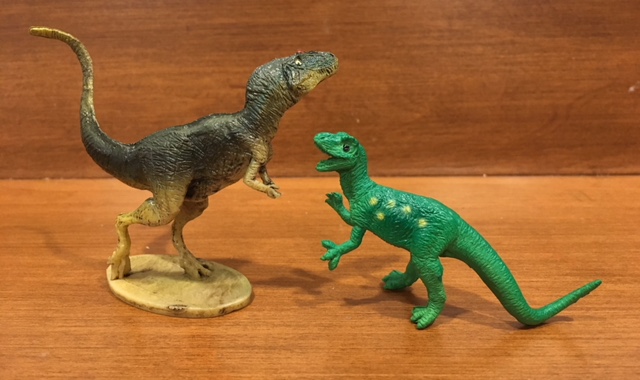
Representing Europe in this lineup is Baryonyx. Like the Allosaurus, this 7 cm long figure is based on the Carnegie Collection version. Pale green with rust brown stripes, black eyes, and a basic pitted texture for the skin, it is sculpted in a rearing position–which has the unfortunate effect of making the toy very prone to falling over. While the head is unmistakable for a Baryonyx, or a spinosaur at any rate, the hands are pronated and completely lack the huge claws that gave this animal its name.


The sole South American predator is Carnotaurus. Carnotaurus was the first theropod discovered with skin impressions, so it seems only fitting that this 7 cm long toy boasts the best sculpting out of the assortment (which admittedly isn’t a very high bar). The skin is a mixture of pits, wrinkles, and multiple rows of osteoderms. Sadly, it’s not easy to appreciate this detail given that the toy is entirely painted glossy black. I assume this was done to add a touch of variety to the mix, but all-black was not the best way to do it. Proportions are pretty off too, especially the oversized arms.
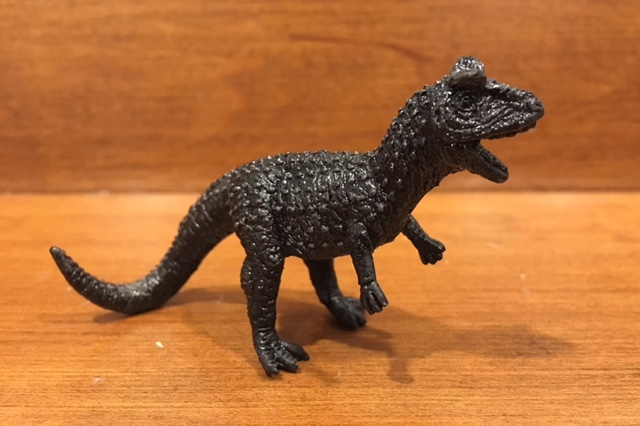

And here we have Dilophosaurus. This 7 cm long killer is sculpted in an “S-pose,” with its head turned sharply to the right and its tail curling to the left. Its main colour is dull yellow with grey wash and black eyes. The skin texture is wrinkly all over, the hands are correctly positioned, and unlike some of the other theropods, this one stands nice and stable. But the twin crests on its head have been brutally botched. Instead of extending all the way down to the nostrils, they’re just fan-shaped protrusions above the brow ridges, making this toy look like some bizarre new beastie. The maxilla also lacks the signature notches.
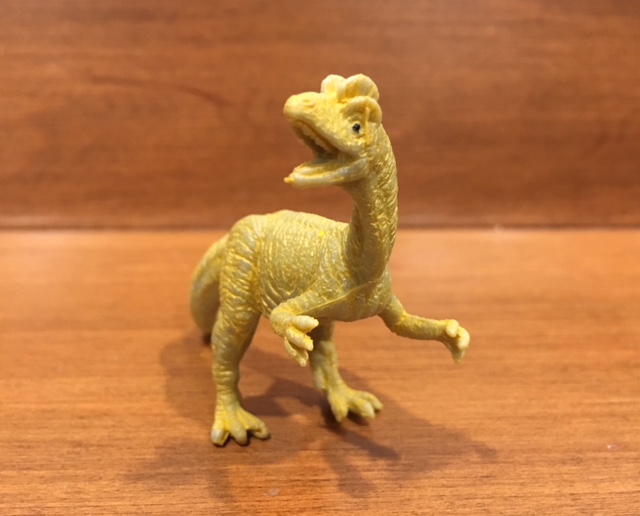
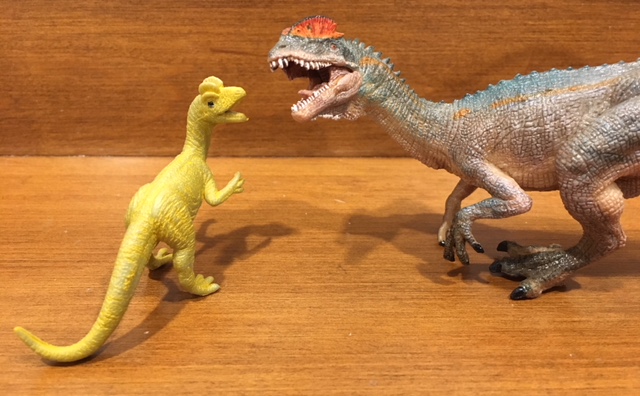
Now we come to the first non-dinosaur and the only non-Mesozoic animal, Dimetrodon. 6.5 cm long, it is beige with dusty brown on its back and sail. The skin is nearly devoid of wrinkles, but the sail has a simple ridged texture. The tail is too stumpy, the neck appears almost, non-existent, and the feet are too big, but I do like how the animal is sculpted in an upright stance with its belly high off the ground.


From the depths of the Cretaceous ocean comes the iconic Elasmosaurus. It measures slightly under 7 cm long and is grey with muddy green airbrushing and black eyes. Most of the body is covered in a faint scale pattern, but the underside is almost completely smooth. The neck is curved around to the right so that the animal can see directly behind it, something that the real deal would have been incapable of achieving without killing itself in the process! As well, the front flippers are too large compared to the hind ones. But on the plus side, this Elasmosaurus can rest on its flippers without its head and neck flopping down.

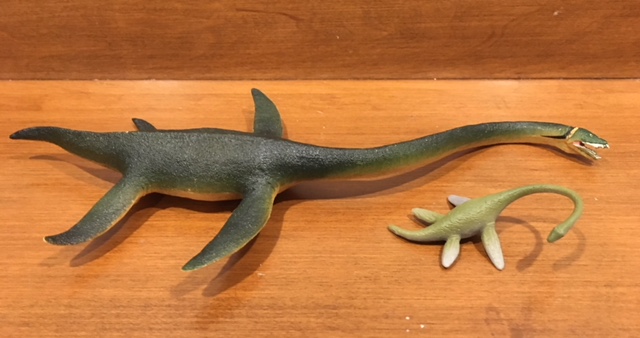
The other sea monster is none other than the awesome Kronosaurus. Grey and black in colour with a pitted skin texture and a length of slightly over 6 cm, it’s one of the more impressive predators in the set thanks to its prominent teeth. Like the Elasmosaurus, the front set of flippers are too large compared to the hind set. The skull is also far too broad. Still, I’d say this is one of the strongest toys in the set (which isn’t saying very much).


A Pteranodon is the token pterosaur here. It measures 4.5 cm long with a 7 cm wingspan and is beige with black eyes and red-orange airbrushing. The wings have a simple leathery texture and the body has faint wrinkles. Like virtually all Pteranodon toys, this one is immediately recognizable, but its bill is too short and it is devoid of pycnofibres. The prominent throat pouch is a nice touch, though!


Let’s get back to the dinosaurs. Here we have a 6.5 cm long Spinosaurus that’s coloured sandy yellow with light orange airbrushing and black eyes and nostrils. The body has basic round scales and there are some unusual circle marks running up the sail. And man, talk about retro! This Spinosaurus is rearing up tall with its arms extended, like a begging dog or a performing circus elephant. The sail is shaped rather like a scallop shell. And the head is generic carnosaur all the way, complete with shrink-wrapped fenestrae. As a result, the toy ends up being quite charming. Stands well too.


Can’t have a set called “Carnivorous Dinos” without Tyrannosaurus rex! At 8 cm, it is one of the longest toys in the set. The main colour is light brown with faint orange airbrushing running down the back and black eyes. The sculpting is probably the second best out of the lot after the Carnotaurus, with lots of scales, wrinkles, and multiple rows of osteoderms. Combined with the dragging tail and raised head, it reminds me very much of this vintage restoration from one of my old dinosaur books. Sadly, this T. rex suffers from a head that’s too small, a neck that’s too long, and arms that are too large. It also falls over to the right if exposed to the slightest breath.


Finally, here’s Velociraptor. Not a whole lot to say about this one. Measuring 8 cm long, it’s afflicted with a chunky body and limbs, no visible claws, and nary a feather on its wrinkled hide. Its colours are pea green and medium green. Despite appearances, it stands up rather well.


As you’ve seen, this tube’s contents are woefully outdated and outclassed by today’s standards. Unless you’re a big fan of miniatures or vintage dinosaurs, I wouldn’t bother with it. Nevertheless, this tube and others like it are still readily available in stores such as Michael’s. As I noted in my intro, it would certainly be nice if Safari produced some brand new prehistoric tubes to match CollectA’s, but I suppose that as long as their old ones continue to sell, they’ll continue to make them.
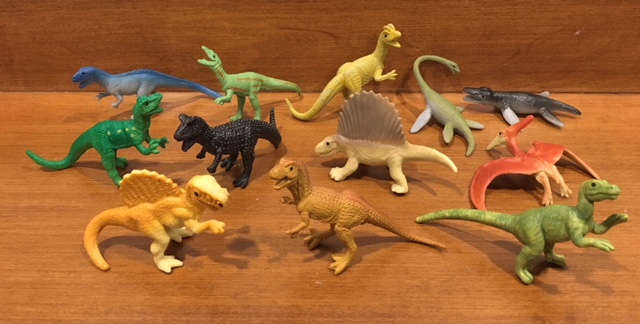
Disclaimer: links to Ebay and Amazon on the DinoToyBlog are affiliate links, so we make a small commission if you use them. Thanks for supporting us!




I have an older version of this tube with much better paint applications. The Acrocanthosaurus looked MUCH closer to the Carnegie version with the same patterning, the Dimetrodon had a more purple body and orange sail I believe, the Carnotaurus was gray with a more elaborate paint scheme including black highlights – similar to the Carnegie but more of a blue-gray hue and no red patch. Elasmosaurus and Kronosaurus were more blue. Spinosaurus had a different pattern but similar coloration… and finally tyhe Velociraptor had a brown-orange base with black stripes.
The paint apps definitely suffer on this newer version, yikes 🙁
I think I had that version too. unfortunately as some of my first dinosaurs, most of them got lost pretty quickly. but I had the Carnotaurus for quite a while and can vouch for the superior color scheme.
Actually, the Allosaurus and Acrocanthosaurus are at least loosely based on their Carnegie counterparts as well. I’m pretty sure the Velociraptor and Spinosaurus are from the same molds as the Mini Carnegie collection.
Yeah, the Acro, the Carno, the Spino, and the raptor all used to have color schemes based on their Carnegie counterparts. The newer, plainer colors don’t do these minis any favors.
I think the Tyannosaurus also resembles the Wild Safari Gorgosaurus in pose and color, coincidentally or not.